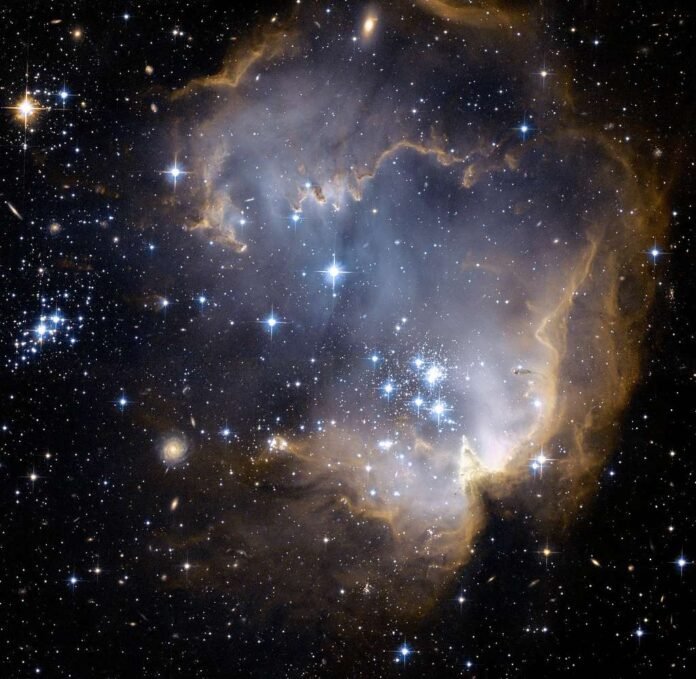In the heart of the constellation Circinus, 2,500 light-years from Earth, a celestial clash is unfolding between darkness and light — and the National Science Foundation’s Dark Energy Camera has captured it in breathtaking detail. The object of fascination: the Circinus West molecular cloud, a massive “dark nebula” so densely packed with gas and dust that it is nearly impervious to visible light.
Yet, within this black veil, something extraordinary is happening. Infant stars — recently formed from the very gas that obscures them — are breaking free of their cocoon. As they erupt with powerful jets of energy, they pierce the darkness in a chaotic process that may closely resemble how our own solar system formed billions of years ago.
What Is the Circinus West Molecular Cloud?
Often referred to as a “stellar nursery,” the Circinus West molecular cloud stretches 180 light-years across — more than 60 times the width of our solar system. Containing a mass equivalent to 250,000 suns, the cloud is made of cold, dense gas and dust ideal for star formation.
READ MORE: Vast Molecular Cloud Discovered Near Solar System, Opening New Frontiers in Astronomy
Molecular clouds like Circinus West are often invisible in regular stargazing because of their density. These “dark nebulae” absorb and scatter light, rendering their interiors opaque to most telescopes. But new imaging technology is changing that.
The Dark Energy Camera (DECam) — one of the world’s most powerful digital cameras, mounted atop the Cerro Tololo Inter-American Observatory in Chile — has now offered one of the clearest glimpses into such a cloud ever captured.
Star Birth in Real Time
The DECam’s new images show bright pinpricks of light erupting from within the cloud: baby stars, or protostars, emitting powerful radiation as they ignite. These eruptions are not just beautiful — they are violently transformative. As these young stars release bursts of high-speed gas, they push against the surrounding cloud, punching holes through it and sculpting it into tattered, tendril-like forms.
Zoomed-in views of the cloud reveal Herbig-Haro objects — brilliant jets of gas created when fast-moving matter from newborn stars collides with slower-moving gas nearby. These glowing structures, named after astronomers George Herbig and Guillermo Haro, appear like lightsabers cutting through the cosmos. Their presence confirms active star formation and offers key insights into how young stars shape — and are shaped by — their environments.
Why This Discovery Matters
According to researchers at the National Optical-Infrared Astronomy Research Laboratory (NOIRLab), regions like Circinus West serve as natural laboratories for studying the physics of star formation. Here, scientists can observe:
- How stars form in clusters
- How jets and radiation from young stars impact their environment
- How dark, cold gas clouds evolve into bright, vibrant regions teeming with life-giving energy
“Investigating regions where stars are actively interacting with their environment is crucial for understanding galaxy formation and evolution,” said representatives from NOIRLab. “These are the cosmic crucibles in which planets, solar systems, and perhaps life are forged.”
Parallels to Our Own Solar System
Perhaps most compelling is what Circinus West can tell us about our own cosmic history. Astronomers believe that our solar system likely formed under similar turbulent conditions, within a dark molecular cloud now long dispersed.
Studying areas like Circinus West could help answer enduring questions about our origins:
- What triggered the collapse of the gas cloud that formed the Sun?
- How did radiation and jet activity shape the early solar environment?
- What role did external factors — like nearby supernovae or massive stars — play in determining the chemistry of our planets?
As stars grow, die, and influence their surroundings, they leave behind patterns that scientists can decode. The traces of ancient violence within our solar system’s chemistry — from rare isotopes to comet compositions — may reflect a chaotic birthing process not unlike what is occurring in Circinus today.
Tools of Discovery: The Dark Energy Camera
This breakthrough was made possible by the Dark Energy Camera, designed to study dark energy but versatile enough to illuminate some of the darkest corners of space.
Mounted on the Victor M. Blanco 4-meter Telescope, the DECam can capture images of immense scale and resolution. Its sensitivity to faint light makes it ideal for detecting the soft glow of distant or obscured cosmic phenomena.
In this observation, DECam didn’t just capture the darkness — it revealed what lies beyond it.
What Comes Next?
Researchers are eager to pair data from DECam with that from other powerful observatories, including:
- The James Webb Space Telescope (JWST), which could provide infrared data to penetrate even deeper into the cloud’s core
- ALMA (Atacama Large Millimeter/submillimeter Array), which could detect molecular fingerprints within the cloud’s densest regions
- Future UV and X-ray missions, which could capture high-energy processes like shockwaves and supernova feedback
Each new observation offers another piece of the puzzle — a step closer to understanding not just how stars and planets form, but how we came to be.
In the Battle of Light vs. Dark, Light Is Winning
The image of Circinus West is a reminder that the universe is not static. It is dynamic, evolving, and alive. Dark clouds do not stay dark forever. Through the force of stellar birth and the chaos of molecular physics, they are reshaped, lit from within, and eventually dispersed — leaving behind stars, planets, and the ingredients for life.
As we peer into this distant battle between light and dark, we may be looking at a mirror of our own beginnings — a silent but vivid echo of a cosmic story written across the skies.
